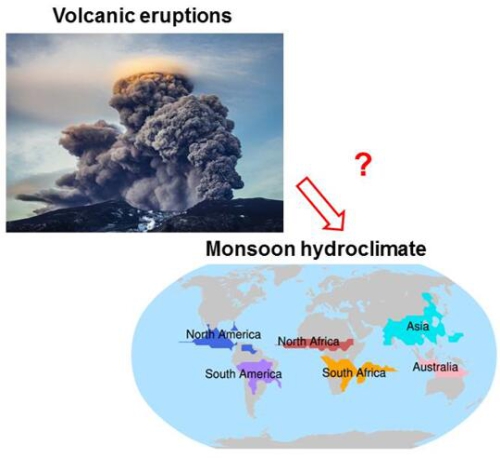Volcanic eruptions eject sulfur dioxide gas high into the atmosphere, forming sulfate aerosol chemically and block the incoming sunlight like a parasol. This causes surface cooling globally, but the response of global monsoon rainfall is different following volcano eruptions at different latitudes, according to a quantitative research by ZUO Meng, a PhD candidate from the Institute of Atmospheric Physics, Chinese Academy of Sciences, along with her mentors Prof. ZHOU Tianjun and associate Prof. MAN Wenmin.
Their work is recently published in Journal of Climate.
Monsoon rainfall and volcano eruption
Monsoon rainfall imposes great impacts on society since it affects over two-thirds of the world’s population. Insufficient monsoon rainfall brings drought and famines to many parts of the world, while too much rainfall causes floods.
Following tropical volcanic eruptions, the monsoon circulation weakens and rainfall decreases consequently. But when we take the latitude of eruptions into consideration, the monsoon rainfall response changes accordingly. This phenomenon has been found in previous studies but the physical mechanism still remains inconclusive (Figure 1). Also the knowledge of the monsoon rainfall response to volcanic eruptions is crucial for adaptation.
The dominant role of atmospheric circulation change
The researchers analyzed large sets of data and the climate model simulations to investigate the different impacts of northern, tropical and southern volcanic eruptions on the global monsoon rainfall. “In contrast to previous work, we used a diagnostic method to quantitatively analyze the factors determining rainfall response, which is helpful to understand the different physical processes of volcanoes at different latitudes affecting the monsoon rainfall”, introduced Dr. ZUO.
The team found that both the proxy and observations show that monsoon rainfall in one hemisphere is reduced by the volcanic eruptions in the same hemisphere, but is enhanced by the volcanic forcing in the other hemisphere. Similar relationship is found in the model simulations.

Figure 1. Relationship between volcanic eruptions and global monsoon hydroclimate. The bottom panel shows the distribution of global monsoon regions. (Image by ZUO Meng. The top panel is from google images)
They further put forward the underlying mechanism by using moisture budget analysis and moisture static energy budget analysis, which can decompose rainfall changes into water vapor change and circulation change. The changes in atmospheric circulation is found to play a dominant role in rainfall responses. The dry-wet changes are attributed to weakened monsoon circulation and enhanced hemispheric thermal contrast, respectively. They also found that the response of the extreme rainfall is consistent with that of the mean rainfall, but more sensitive over monsoon regions, which are related to drought and flood hazards.
"This work implies that future volcanic eruptions located in different latitudes will impact the monsoon rainfall differently through circulation changes, which implies that the rainfall response to volcanic eruptions at different hemispheres should be considered in the design of Decadal Climate Prediction Project (DCPP) experiments and the implementation of geoengineering activities", the corresponding author Prof. ZHOU Tianjun, highlighted.
Citation:
Zuo Meng, Tianjun Zhou*, Wenmin Man, 2019: Hydroclimate Responses over Global Monsoon Regions Following Volcanic Eruptions at Different Latitudes.Journal of Climate, 32, 4367-4385. DOI: 10.1175/JCLI-D-18-0707.1
https://journals.ametsoc.org/doi/10.1175/JCLI-D-18-0707.1
Media contact: Ms. LIN Zheng, jennylin@mail.iap.ac.cn
